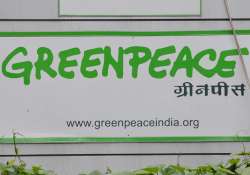India's nuclear disaster emergency plans 'outdated': Greenpeace
India's nuclear disaster emergency plans are "not in line with international standard" and some interventions set by Indian nuclear regulator in case of an emergency provide "inadequate" protection against possible radiation, Grrenpeace India claimed

New Delhi: India's nuclear disaster emergency plans are "not in line with international standard" and some interventions set by Indian nuclear regulator in case of an emergency provide "inadequate" protection against possible radiation, Greenpeace India claimed today.
"Some of the disaster intervention levels set by the Indian nuclear regulator allow inadequate protection against possible exposure, both internal (from consumption of irradiated foodstuffs or radioactive particle-laden air) and external (by simply being physically present in an area with high radiation levels) in case of a nuclear emergency," it alleged.
The NGO, which released a report 'Red Alert - India's nuclear disaster plans outdated and inadequate', highlighted key issues like "lack" of emergency preparedness, "ancient" manual for emergency guidelines, "unacceptable" standards of food contamination among the reasons for India's plans being "outdated" in case of an emergency.
Referring to the recent "accident" at Kakrapar Atomic Power Station (KAPS) in Gujarat, Greenpeace India said it proved that India's nuclear accident plans are "not in line" with international standards.
The report highlighted that population density around nuclear power plants in India poses a "significant" evacuation challenge in the event of an emergency.
"The current evacuation plans only provide support within a radius of 16 km in case of an offsite nuclear accident. For Fukushima, Japan had to set an evacuation zone of 30 km. Our report examines such differences and provides recommendations for the authorities to act upon," said David Boilley, Director ACRO Labs and lead author of the report.
The NGO further said the manual on emergency preparedness at Kalpakkam, despite being revised in April 2011, still includes a regulatory guideline with intervention levels based on Publication 40 of the International Commission on Radiological Protection (ICRP) adopted in 1984 which was well before the Chernobyl disaster.
There have been updates to these international guidelines in 1992, and then again in 2007 but the Atomic Energy Regulatory Board (AERB) has not updated its guidelines for 26 years, it said.
Greenpeace India claimed India's acceptable limit of contaminated food are "set dangerously higher" than international limits.
In case of an accident, counter measures are initiated only if contamination is in the range between 8,000 Bq/kg in meat to 90,000 Bq/kg in fruits and vegetables.
In comparison, any organic matter with more than 8,000 Bq/kg of cesium is considered as radioactive waste in Japan.
"Effectively, this means India will allow the consumption of irradiated food which, in other countries such as Japan, would be termed radioactive waste," Boilley said.
"The Kakrapar accident proved that India's nuclear accident plans are not in line with international standards. Only four public updates were provided in 21 days of continued plant emergency at Kakrapar nuclear station," Hozefa Merchant, Senior Nuclear Campaigner for Greenpeace India alleged.
Merchant said while in opposition, BJP supported a stronger liability regime as well as strong regulations on safety.
"Now that it enjoys a majority at the Centre and considering the growing international influence being exerted by Prime Minister Narendra Modi, his party is uniquely placed to implement strong regulations for protecting India and its citizens against nuclear accidents," Merchant said.